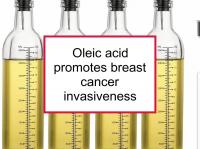A new study has reported that oleic acid, the predominant fatty acid in olive oil, promotes an increase in breast cancer cell invasiveness in the laboratory. Both animal studies and population studies have reported associations between dietary fatty acids and increased risk of developing breast cancer.
Obesity, which is characterized by high cholesterol, high triglycerides, and an elevated level of circulating free fatty acids, is also associated with increased risk of cancer. The free fatty acid oleic acid has previously been shown to induce migration and proliferation in breast cancer cells, as well as prolonging survival and invasion.
However, until now, the role of oleic acid on matrix metalloproteinase-9 (MMP-9) secretion and invasion has not been studied in detail. MMPs are enzymes essential for the degradation of most components of the extracellular matrix (the non-cellular portion of tissues which provides structural support to the cells), and thereby have a role in multiple biological processes, including inflammation, infection, and tumor invasion and metastasis.
In the study, the authors demonstrated that stimulation of breast cancer cells with oleic acid led to an increase in MMP-9 secretion. On the other hand, oleic acid did not bring about an increase in MMP-9 secretion in non-cancerous breast cells. The authors conclude that oleic acid promotes an increase in MMP-9 secretion and invasion in breast cancer cells.
Food sources of oleic acid
Oleic acid is a monounsaturated omega-9 fatty acid which is a major component of olive oil and canola oil, but is also found in most commonly consumed oils and fats:Olive oil has been shown to be protective against HER2+ breast cancer. Generally speaking, the percentage of oleic acid in a fat does not appear to be directly correlated with the impact of the fat on the risk of breast cancer. For example, corn oil has the same level of oleic acid as walnut oil, but corn oil has been shown to promote breast cancer whereas walnut oil is thought to be protective. The influence of a given oil is based on numerous factors, including the other fatty acids that make up the oil and its phytochemical and other non-oil components.
- Fat
- Olive oil
- Canola oil
- Peanut oil
- Lard
- Beef fat
- Sesame oil
- Butterfat
- Walnut oil
- Corn oil
- Soybean oil
- Flaxseed oil
- Sunflower oil
- Grape seed oil
- Safflower oil
- % Oleic Acid
- 71
- 62
- 48
- 44
- 43
- 41
- 29
- 28
- 28
- 24
- 21
- 19
- 15
- 13
Having said this, we are not suggesting that the results of the study be ignored. Other studies have also reported that oleic acid promotes breast cancer. We conclude that consuming extra-virgin olive oil is probably preferable to using highly refined olive oil, which may have more of the characteristics of the “pure” oleic acid used in the study.
